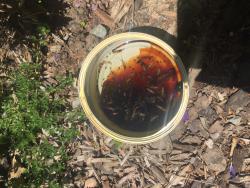Professional Native Landscape Design
Blog Post
Controlling Earwigs
posted: June 26th, 2020
When you see "skeletonized" leaves, that is, ragged edges or holes in leaves or the petals of a plant, sometimes leaving only a skeleton of the leaf, that's proof you have earwigs foraging on your plants at night. We talk about "controlling" them because you will never get rid of them completely. Spraying is completely ineffective and may even harm your plants. Take it from me, I ruined a butterfly bush by spraying it with a so-called "natural" cinnamon and mint spray recommended by a well-meaning Grange sales associate.
Create a less enticing environment
- Remove the objects earwigs seek out for hiding places, this includes stacks of wood, piles of weeds, grass clippings and other plant debris.
- Pull mulch at least six inches away from tender plant stems.
- Earwigs love damp conditions, so water your garden and lawn only when necessary.
- Turn off as many outdoor lights as possible after dark, earwigs are attracted to light.
- Reduce or eliminate the use of all pesticides. There are many insects who like to eat earwigs, so, as always, it's imperative that you eliminate pesticide use. 99% of all insects are beneficial, but they get killed by pesticide, too.
Making Earwig traps
It's easy to make a trap and catch dozens of these little pests every night, along with some pill bugs and slugs! You'll need 3 things: A low-sided container, cheap oil and soy sauce. The soy lures the pests with the promise of something yummy and salty, the oil traps and drowns them.
- Low-sided container. I use cat food cans, but tuna cans or a low hummus or salsa container will work just as well. I leave the container open, but if you have overhead sprinklers, you'll need to use the lid. Poke penny-nail holes in the upper sides of the container and pour in
- Soy sauce 1/4 way up the side.
- Pour in cheap oil (my only use for canola!) below the holes if using a lid, or just about to the top of the cat food or tuna can. Beware of animals wanting to eat the mixture! Ollie sampled it the other day! Deer can knock over your containers, too, so be sure to check them periodically.
- Yuck! There is a real "yuck" factor to this, but it beats the alternative method of rolling up wet newspapers and shaking out the live earwigs into a bucket of soap water every morning. When I tried this, half of them ended up crawling up my arm! I was horrified.
Please try it and let me know if this method works for you!



